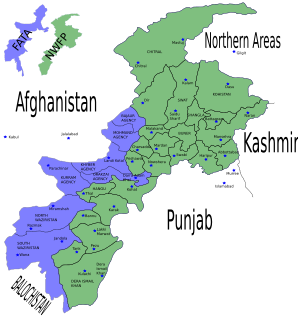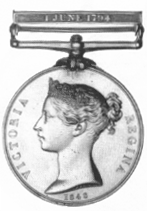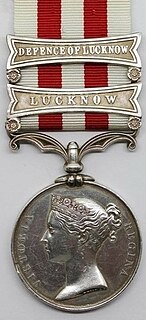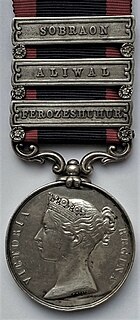
The First Anglo-Sikh War was fought between the Sikh Empire and the East India Company in 1845 and 1846. It resulted in partial subjugation of the Sikh kingdom and cession of Jammu and Kashmir as a separate princely state under British suzerainty.

The Second Anglo-Sikh War(First War of Sikh Independence) was a military conflict between the Sikh Empire and the British East India Company that took place in 1848 and 1849. It resulted in the fall of the Sikh Empire, and the annexation of the Punjab and what subsequently became the North-West Frontier Province, by the East India Company.

Major General Sir Henry Tombs VC KCB was a recipient of the Victoria Cross, the highest and most prestigious award for gallantry in the face of the enemy that can be awarded to British and Commonwealth forces.

The North-West Frontier was a region of the British Indian Empire. It remains the western frontier of present-day Pakistan, extending from the Pamir Knot in the north to the Koh-i-Malik Siah in the west, and separating the modern Pakistani frontier regions of North-West Frontier Province, Federally Administered Tribal Areas and Balochistan from neighbouring Afghanistan in the west. The borderline between is officially known as the Durand Line and divides Pashtun inhabitants of these provinces from Pashtuns in eastern Afghanistan.
The Battle of Chillianwala was fought in January 1849 during the Second Anglo-Sikh War in the Chillianwala region of Punjab, now part of modern-day Pakistan. The battle was one of the bloodiest fought by the British East India Company. Both armies held their positions at the end of the battle and both sides claimed victory. The battle was a strategic check to immediate British ambitions in India and a shock to British military prestige.
The Battle of Ramnagar was fought on 22 November 1848 between British and Sikh forces during the Second Anglo-Sikh War. The British were led by Sir Hugh Gough, while the Sikhs were led by Sher Singh Attariwalla. The Sikhs repelled an attempted British surprise attack.

The Battle of Gujrat was a decisive battle in the Second Anglo-Sikh War, fought on 21 February 1849, between the forces of the East India Company, and a Sikh army in rebellion against the Company's control of the Sikh Empire, represented by the child Maharaja Duleep Singh who was in British custody in Lahore. The Sikh army was defeated by the British regular and Bengal Army forces of the British East India Company. After it capitulated a few days later, the Punjab was annexed to the East India Company's territories and Duleep Singh was deposed.
The Siege of Multan was a prolonged contest between the city and state of Multan and the British East India Company. The siege lasted between 19 April 1848, when a rebellion in the city against a ruler imposed by the East India Company precipitated the Second Anglo-Sikh War, and 22 January 1849, when the last defenders surrendered.

The 1939–1945 Star is a military campaign medal instituted by the United Kingdom on 8 July 1943 for award to British and Commonwealth forces for service in the Second World War. Two clasps were instituted to be worn on the medal ribbon, Battle of Britain and Bomber Command.

The Naval General Service Medal (NGSM) was a campaign medal approved in 1847, and issued to officers and men of the Royal Navy in 1849. The final date for submitting claims was 1 May 1851. Admiral Thomas Bladen Capel was one of the members of the board that authorised the medal.

The Military General Service Medal (MGSM) was a campaign medal approved in 1847 and issued to officers and men of the British Army in 1848.

The Indian Mutiny Medal was a campaign medal approved in August 1858, for issue to officers and men of British and Indian units who served in operations in suppression of the Indian Mutiny.

The Burma Star is a military campaign medal, instituted by the United Kingdom in May 1945 for award to British and Commonwealth forces who served in the Burma Campaign from 1941 to 1945, during the Second World War.

The Sutlej Medal was a campaign medal approved in 1846, for issue to officers and men of the British Army and Honourable East India Company who served in the Sutlej campaign of 1845-46. This medal was the first to use clasps to denote soldiers who fought in the major battles of the campaign.

The India Medal was a campaign medal approved in 1896 for issue to officers and men of the British and Indian armies.

The Africa General Service Medal, established in 1902, was a campaign medal of the United Kingdom. It was awarded for minor campaigns that took place in tropical Africa between 1900 and 1956, with a total of forty five clasps issued. The medal is never seen without a clasp and some are very rare. Most medals were granted to British led local forces, including the King's African Rifles and the West African Frontier Force. The only campaigns where European troops were present in any numbers were the various Somaliland campaigns,, and in Kenya.

The Queen's Sudan Medal was authorised in March 1899 and awarded to British and Egyptian forces which took part in the Sudan campaign between June 1896 and September 1898.

The Ashanti Medal was sanctioned in October 1901 and was the first campaign medal authorised by Edward VII. This medal was created for those troops that were engaged in the Third Ashanti Expedition, also known as the War of the Golden Stool. This expedition lasted from March – December 1900, with the final outcome that the Ashanti maintained its de facto independence. Ashanti was made a Protectorate of the British Empire, but they ruled themselves with little reference to the colonial power.

The Central Africa Medal was a British campaign medal awarded for service from 1891–1894 in Eastern and Central Africa, and from 1894–1898 for service in British Central Africa.
This page is based on this
Wikipedia article Text is available under the
CC BY-SA 4.0 license; additional terms may apply.
Images, videos and audio are available under their respective licenses.

















